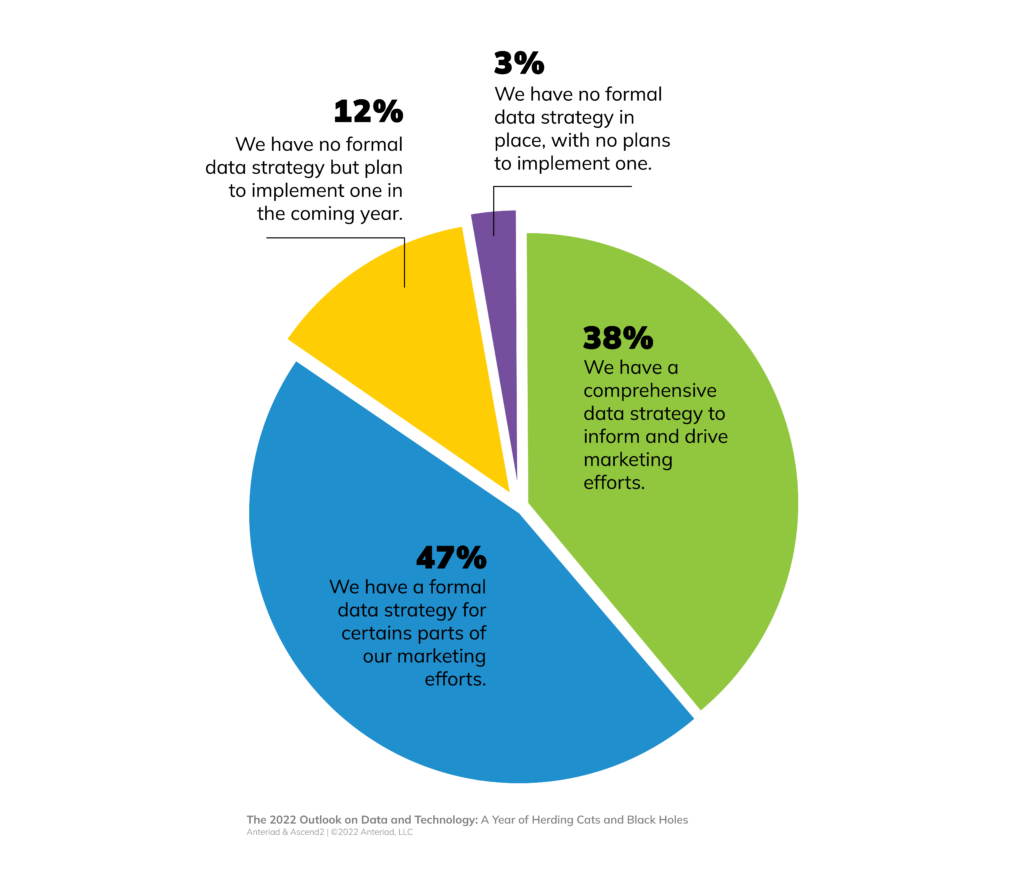Our recent study with Ascend2 (The 2022 Outlook on Data and Technology: A Year of Herding Cats and Black Holes) provided insight into how marketers approach data and technology in the current marketing landscape. We’re digging deeper into some of the results in our three-part blog series Breaking Down the Data.
Last week, we discussed marketing revenue and budgets. Today, we’re talking about data strategy.
Insight 1: Comprehensive Data Strategy is Crucial
Developing a marketing data strategy can be a daunting task. But according to our recent study, it’s vital to growing your company.
We asked our survey respondents if they had a comprehensive data strategy, and only about a third responded that they did. Almost half of our respondents have a formal strategy for some of their efforts, but most don’t have a comprehensive strategy. This may seem like a small distinction, but it becomes a big difference when we drill down into the data.

Normalized Data
Those with a comprehensive strategy are twice as likely to have extensively normalized data. This matters because having normalized data allows you to use your data throughout the customer lifecycle effectively.
Not only will normalization eliminate duplicates, it will ensure that your data can easily flow into all of your systems. It will also help to make reporting easier since all of your data will be categorized in the same way.
Speed to Market
Having a comprehensive data strategy also means you can go to market much faster. In fact, respondents who have a comprehensive strategy are almost twice as likely to launch a campaign in 15 days or less. But a strategy doesn’t just make you faster – a lack of strategy also makes you slower. Teams without a comprehensive strategy are twice as likely to need 61-90 days to get a campaign in market, and almost half need more than a month!

Time to market can have a significant impact on your bottom line, especially in competitive markets and when market conditions are changing rapidly. Being able to go to market quickly gives you a leg up on your competition.
Revenue
But here’s the kicker—twice as many respondents with a comprehensive data strategy reported their revenue grew by 20% or more over the last year compared to those without. Read that again. Twice as many.
This shows that data strategy really does correlate to business growth.
You need a comprehensive strategy now – especially now.
Insight 2: Collecting the Right Data is Crucial
Data and ABM
Most survey respondents said they are currently executing account-based marketing (ABM) programs or plan to start them soon. That’s great.
However, we found that only 43% feel they are collecting the right data to target and segment their audiences – which means that 57% aren’t. And that data is crucial when you’re running ABM.
Whether you’re already running ABM programs or you’re still in the planning stage, take time to identify gaps in your data. The first step toward collecting the right data is determining what data you need. Once you have figured that out, you can identify where that data will come from—and what tool will collect it. Your final step is the most difficult one: setting up your tools to collect the data you need. It isn't a quick process, and it probably won't be easy, but the results will pay off in the long run.
Intent Data
Roughly 95% of respondents used intent data in 2022, and 57% plan to increase their use of intent data in 2023. Additionally, the marketers that plan to significantly increase their use of intent data were 2.6x as likely to anticipate their ability to meet their KPIs to significantly increase. This shows that more intent data means better results.
If you aren’t planning to ramp up your use of intent data, you probably should be.
And remember to use intent data with your existing customers, too—not just with your net new logos. Especially if you’re expecting to drive revenue through cross-sell and upsell opportunities.
Insight 3: Alignment Matters
Developing a strategy is just the first step. You also need to implement and evaluate it to make sure you’re meeting your business goals.
We asked our respondents how they measured success; overall, we saw similar trends across the board. Marketers are generally looking at marketing qualified leads, sales qualified leads, sales accepted leads, and their campaigns’ open and click-through rates.

As you plan for 2023, it’s important to align with your team on how you’ll measure the success of your marketing efforts. If your team isn’t already aligned on which metrics matter most, use the list above as your starting point.
And be sure to include your execs in the conversation so that you know what they’re expecting to hear about. (We talked about this in more detail in last week’s blog.)
The Takeaway
We’ll say it again: Having a comprehensive data strategy pays off. If you don’t have one, make it a priority to create one. Work with your team to develop a strategy and determine how you will measure its success.
Why? Because creating a comprehensive data strategy could be the key to growing your business.
To learn more about what our survey responses showed us, read The 2022 Outlook on Data and Technology: A Year of Herding Cats and Black Holes.
To get more specific, check out 2022 Marketing Trends: UK vs. US and Part 1 of this series, Breaking Down the Data: Marketing Revenue and Budgets.
.png?width=290&name=MicrosoftTeams-image%20(26).png)


